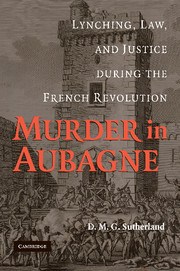Book contents
- Frontmatter
- Contents
- List of Figures
- Preface
- Acknowledgments
- Abbreviations
- Aubagne: An Introduction to the Problem
- 1 Structures and Events
- 2 The Olive Festival
- 3 Aubagne's Universe: Marseille, Aix, and Arles, 1789–1792
- 4 Murders in Provence
- 5 Vigilantism and Federalism
- 6 Federalism
- 7 Terror in a Small Town: Aubagne
- 8 The Revolution of the Antiterrorists: Vengeance, Massacre, and Justice
- 9 The Bande d'Aubagne
- Conclusion
- Appendix
- Sources and Methods
- Index
Conclusion
Published online by Cambridge University Press: 13 August 2009
- Frontmatter
- Contents
- List of Figures
- Preface
- Acknowledgments
- Abbreviations
- Aubagne: An Introduction to the Problem
- 1 Structures and Events
- 2 The Olive Festival
- 3 Aubagne's Universe: Marseille, Aix, and Arles, 1789–1792
- 4 Murders in Provence
- 5 Vigilantism and Federalism
- 6 Federalism
- 7 Terror in a Small Town: Aubagne
- 8 The Revolution of the Antiterrorists: Vengeance, Massacre, and Justice
- 9 The Bande d'Aubagne
- Conclusion
- Appendix
- Sources and Methods
- Index
Summary
The discovery of the Julliens' bodies leads backward into Aubagne's recent past and outward to its sister towns and cities. The Julliens were victims of the factional politics that had flared up early in 1789. Factionalism in turn is the avenue toward an exploration of small-town violence during the Revolution. Reflections on the broader significance of this story have much to teach historians.
This study began as a microhistory. The purpose of the genre is to construct a paradigm that explains a larger problem by means of a single case study. In this instance, the example is the murders in a small town in Provence, while the larger problem is the interpretation of revolutionary violence in the years from 1789 to 1799. Yet the genre usually privileges a single source – abundant records from a trial, perhaps – and intuits the wider significance. Without the wider context that situates the case study, however, the step toward demonstrating the significance is risky. A researcher working from the trial of the members of the bande d'Aubagne alone might conclude that the violence of the Revolution was ultimately senseless. With an abundance of documentation on the region and especially on the role of Marseille, however, the researcher is bound to stumble on the phenomenon of violent democracy. This in turn means that violence in Aubagne and throughout Provence is comprehensible, but also that it was not paradigmatic of France as a whole.
The violence so common in this region had few counterparts elsewhere in the country.
- Type
- Chapter
- Information
- Murder in AubagneLynching, Law, and Justice during the French Revolution, pp. 285 - 292Publisher: Cambridge University PressPrint publication year: 2009

